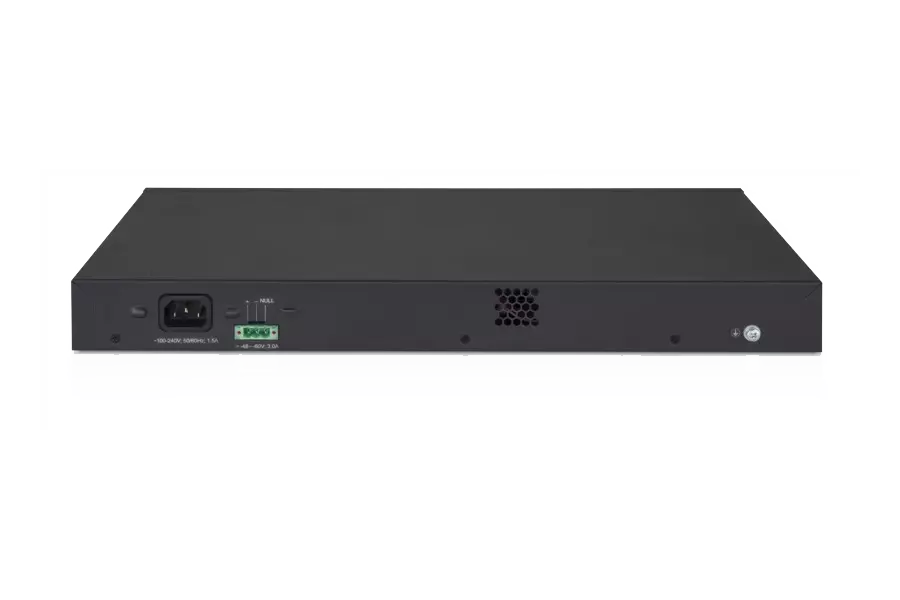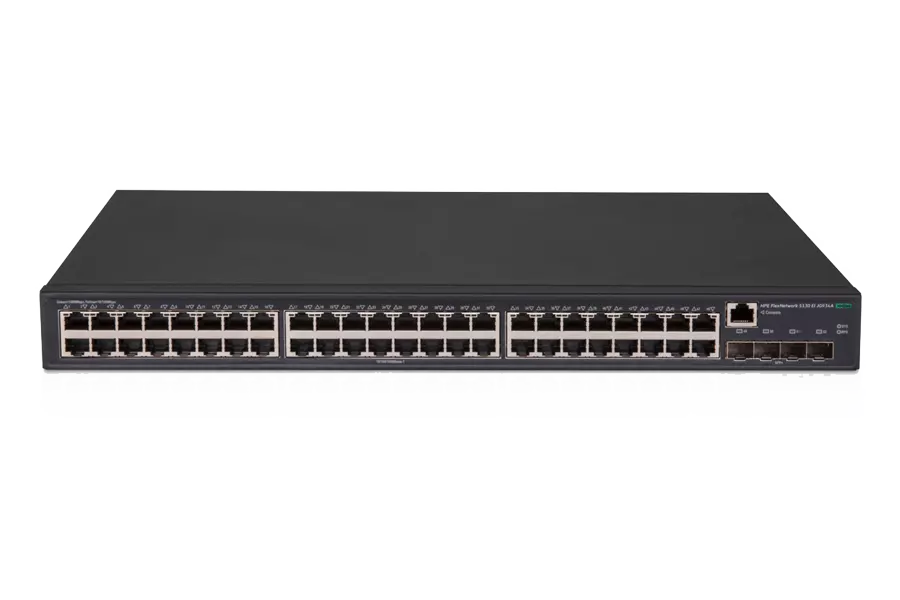

HPE 5130 48G 4SFP+ EI Switch
HPE 5130 48G 4SFP+ EI Switch, Managed-Basic L3,10/100/1000Mbps
Description
HPE FlexNetwork 5130 EI Switch Series
The HPE FlexNetwork 5130 EI Switch Series comprises Gigabit Ethernet switches that support static and RIP Layer 3 routing, diversified services, and IPv6 forwarding, as well as provide four 10-Gigabit Ethernet (10GbE) interfaces.
Unique Intelligent Resilient Fabric (IRF) technology creates a virtual fabric by managing several switches as one logical device, which increases network resilience, performance, and availability, while reducing operational complexity. These switches provide Gigabit Ethernet access and can be used at the edge of a network or to connect server clusters in small data centers.
High availability, simplified management, and comprehensive security control policies are among the key features that distinguish this series.
Key features
- Fixed 10GbE ports for high-speed stacking or uplinks
- Support for multiple services
- Comprehensive security control policies
- Diversified quality of service (QoS) policies
- Excellent manageability
Features and benefits
Software-defined networking
- OpenFlow : supports OpenFlow 1.3 specification to enable SDN by allowing separation of the data (packet forwarding) and control (routing decision) paths
Quality of Service (QoS)
- Broadcast control : allows limitation of broadcast traffic rate to cut down on unwanted network broadcast traffic
- Advanced classifier-based QoS : classifies traffic using multiple match criteria based on Layer 2, 3, and 4 information; applies QoS policies such as setting priority level and rate limit to selected traffic on a port, VLAN, or whole switch
- Powerful QoS feature : supports the following congestion actions: strict priority (SP) queuing, weighted round robin (WRR), and SP+WRR
- Traffic policing : supports Committed Access Rate (CAR) and line rate
Connectivity
- Auto-MDIX : automatically adjusts for straight-through or crossover cables on all 10/100/1000 ports
- Flow control : provides back pressure using standard IEEE 802.3x, reducing congestion in heavy traffic situations
- High-density connectivity : provides up to 48 fixed 10/100/1000BASE-T ports in a Layer 2/Layer 3 switch
- IEEE 802.3at Power over Ethernet (PoE+) support : simplifies deployment and dramatically reduces installation costs by helping to eliminate the time and cost involved in supplying local power at each access point location
- Ethernet operations, administration and maintenance (OAM) : detects data link layer problems that occurred in the "last mile" using the IEEE 802.3ah OAM standard; monitors the status of the link between two devices
Resiliency and high availability
- Separate data and control paths : separates control from services and keeps service processing isolated; increases security and performance
- External redundant power supply : provides high reliability
- Smart link : allows 100 ms failover between links
- Spanning Tree/MSTP, RSTP : provides redundant links while preventing network loops; supports up to 64 instances of MSTP
- Intelligent Resilient Fabric (IRF) : creates virtual resilient switching fabrics, where two or more switches perform as a single L2 switch and L3 router; switches do not have to be co-located and can be part of a disaster-recovery system; servers or switches can be attached using standard LACP for automatic load balancing and high availability; can eliminate the need for complex protocols like Spanning Tree Protocol, Equal-Cost Multipath (ECMP), or VRRP, thereby simplifying network operation
Layer 3 routing
- Static IP routing : provides manually configured routing for both IPv4 and IPv6 networks
- Routing Information Protocol (RIP) : uses a distance vector algorithm with UDP packets for route determination; supports RIPv1 and RIPv2 routing; includes loop protection
Management
- Remote configuration and management : enables configuration and management through a secure Web browser or a CLI located on a remote device
- Manager and operator privilege levels : provides read-only (operator) and read/write (manager) access on CLI and Web browser management interfaces
- Command authorization : leverages HWTACACS to link a custom list of CLI commands to an individual network administrator's login; also provides an audit trail
- Secure Web GUI : provides a secure, easy-to-use graphical interface for configuring the module via HTTPS
- Multiple configuration files : stores easily to the flash image
- Complete session logging : provides detailed information for problem identification and resolution
- Remote monitoring (RMON) : uses standard SNMP to monitor essential network functions; supports events, alarm, history, and statistics group plus a private alarm extension group
- IEEE 802.1AB Link Layer Discovery Protocol (LLDP) : advertises and receives management information from adjacent devices on a network, facilitating easy mapping by network management applications
- sFlow (RFC 3176) : provides scalable ASIC-based wirespeed network monitoring and accounting with no impact on network performance; this allows network operators to gather a variety of sophisticated network statistics and information for capacity planning and real-time network monitoring purposes
- Management VLAN : segments traffic to and from management interfaces, including CLI/telnet, a Web browser interface, and SNMP
- Remote intelligent mirroring : mirrors ingress/egress ACL-selected traffic from a switch port or VLAN to a local or remote switch port anywhere on the network
- Device Link Detection Protocol (DLDP) : monitors a cable between two compatible switches and shuts down the ports on both ends if the cable is broken, which prevents network problems such as loops
- IPv6 management : provides future-proof networking because the switch is capable of being managed whether the attached network is running IPv4 or IPv6; supports pingv6, tracertv6, Telnetv6, TFTPv6, DNSv6, syslogv6, FTPv6, SNMPv6, DHCPv6, and RADIUS for IPv6
- Troubleshooting : ingress and egress port monitoring enables network problem-solving; virtual cable tests provide visibility into cable problems
- HPE Intelligent Management Center (IMC) : integrates fault management, element configuration, and network monitoring from a central vantage point; built-in support for third-party devices enables network administrators to centrally manage all network elements with a variety of automated tasks, including discovery, categorization, baseline configurations, and software images; the software also provides configuration comparison tools, version tracking, change alerts, and more
- Network Management : SNMP v1/v2c/v3, MIB-II with Traps, and RADIUS Authentication Client MIB (RFC 2618); embedded HTML management tool with secure access
Security
- Access control lists (ACLs) : provides IP Layer 2 to Layer 4 traffic filtering; supports global ACL, VLAN ACL, port ACL, and IPv6 ACL
- IEEE 802.1X : industry-standard method of user authentication using an IEEE 802.1X supplicant on the client in conjunction with a RADIUS server
- MAC-based authentication : client is authenticated with the RADIUS server based on the client's MAC address
- Identity-driven security and access control
- Per-user ACLs : permits or denies user access to specific network resources based on user identity and time of day, allowing multiple types of users on the same network to access specific network services without risking network security or providing unauthorized access to sensitive data
- Automatic VLAN assignment : automatically assigns users to the appropriate VLAN based on their identities Secure management access delivers secure encryption of all access methods (CLI, GUI, or MIB) through SSHv2, SSL, HTTPS and/or SNMPv3
- Secure FTP/ SCP : allows secure file transfer to and from the switch; protects against unwanted file downloads or unauthorized copying of a switch configuration file
- Guest VLAN : provides a browser-based environment to authenticated clients that is similar to IEEE 802.1X
- Port security : allows access only to specified MAC addresses, which can be learned or specified by the administrator
- Port isolation : secures and adds privacy, and prevents malicious attackers from obtaining user information
- STP BPDU port protection : blocks Bridge Protocol Data Units (BPDUs) on ports that do not require BPDUs, preventing forged BPDU attacks
- STP root guard : protects the root bridge from malicious attacks or configuration mistakes
- DHCP protection : blocks DHCP packets from unauthorized DHCP servers, preventing denial-of-service attacks
- IP source guard : helps prevent IP spoofing attacks
- Dynamic ARP protection : blocks ARP broadcasts from unauthorized hosts, preventing eavesdropping or theft of network data
- RADIUS/HWTACACS : eases switch management security administration by using a password authentication server
Performance
- Nonblocking architecture : up to 176 Gb/s nonblocking switching fabric provides wirespeed switching with up to 143 million pps throughput
- Hardware-based wirespeed access control lists (ACLs) : help provide high levels of security and ease of administration without impacting network performance with a feature-rich TCAM-based ACL implementation
Device support
- Prestandard PoE Support : detects and provides power to prestandard PoE devices such as wireless LAN access points and IP phones
Convergence
- IEEE 802.1AB Link Layer Discovery Protocol (LLDP) : facilitates easy mapping using network management applications with LLDP automated device discovery protocol
- LLDP-MED : is a standard extension that automatically configures network devices, including LLDP-capable IP phones
- LLDP-CDP compatibility : receives and recognizes CDP packets from Cisco's IP phones for seamless interoperation
- IEEE 802.3at Power over Ethernet (PoE+) : provides up to 30 W per port that allows support of the latest PoE+-capable devices such as IP phones, wireless access points, and security cameras, as well as any IEEE 802.3af-compliant end device; eliminates the cost of additional electrical cabling and circuits that would otherwise be necessary in IP phone and WLAN deployments
- PoE allocations : supports multiple methods (automatic, IEEE 802.3af class, LLDP-MED, or user-specified) to allocate PoE power for more efficient energy savings
- Voice VLAN : automatically assigns VLAN and priority for IP phones, simplifying network configuration and maintenance
- IP multicast snooping (data-driven IGMP) : prevents flooding of IP multicast traffic
Additional information
- Green IT and power : improves energy efficiency through the use of the latest advances in silicon development; shuts off unused ports and utilizes variable-speed fans, reducing energy costs
- Green initiative support : provides support for RoHS and WEEE regulations
- Unified Hewlett Packard Enterprise Comware operating system with modular architecture : provides an easy-to-enhance-and-extend feature set, which doesn't require whole-scale changes; all switching, routing, and security platforms leverage the Comware OS, a common unified modular operating system
Energy Efficient Ethernet (EEE) Support
reduces power consumption in accordance with IEEE 802.3az
Layer 2 switching
- 16K MAC address table : provides access to many Layer 2 devices
- VLAN support and tagging : supports IEEE 802.1Q with 4,094 simultaneous VLAN IDs
- IEEE 802.1ad QinQ and selective QinQ : increase the scalability of an Ethernet network by providing a hierarchical structure; connect multiple LANs on a high-speed campus or metro network
- 10GbE port aggregation : allows grouping of ports to increase overall data throughput to a remote device
- Device Link Detection Protocol (DLDP) : monitors link connectivity and shuts down ports at both ends if unidirectional traffic is detected, preventing loops in STPbased networks
- Jumbo Frame Support : improves the performance of large data transfers; supports frame size of up to 9K-bytes
Layer 3 services
- Address Resolution Protocol (ARP) : determines the MAC address of another IP host in the same subnet; supports static ARPs; gratuitous ARP allows detection of duplicate IP addresses; proxy ARP allows normal ARP operation between subnets or when subnets are separated by a Layer 2 network
- Dynamic Host Configuration Protocol (DHCP) : simplifies the management of large IP networks; supports client; DHCP Relay enables DHCP operation across subnets
- Loopback interface address : defines an address that can always be reachable, improving diagnostic capability
- User Datagram Protocol (UDP) helper function : allows UDP broadcasts to be directed across router interfaces to specific IP unicast or subnet broadcast addresses and prevents server spoofing for UDP services such as DHCP
- Route maps : provide more control during route redistribution; allow filtering and altering of route metrics
- DHCP server : centralizes and reduces the cost of IPv4 address management
Warranty and support
- Limited Lifetime Warranty : See http://www.hpe.com/networking/warrantysummary for warranty and support information included with your product purchase.
- Software releases : to find software for your product, refer to http://www.hpe.com/networking/support; for details on the software releases available with your product purchase, refer to http://www.hpe.com/networking/warrantysummary
